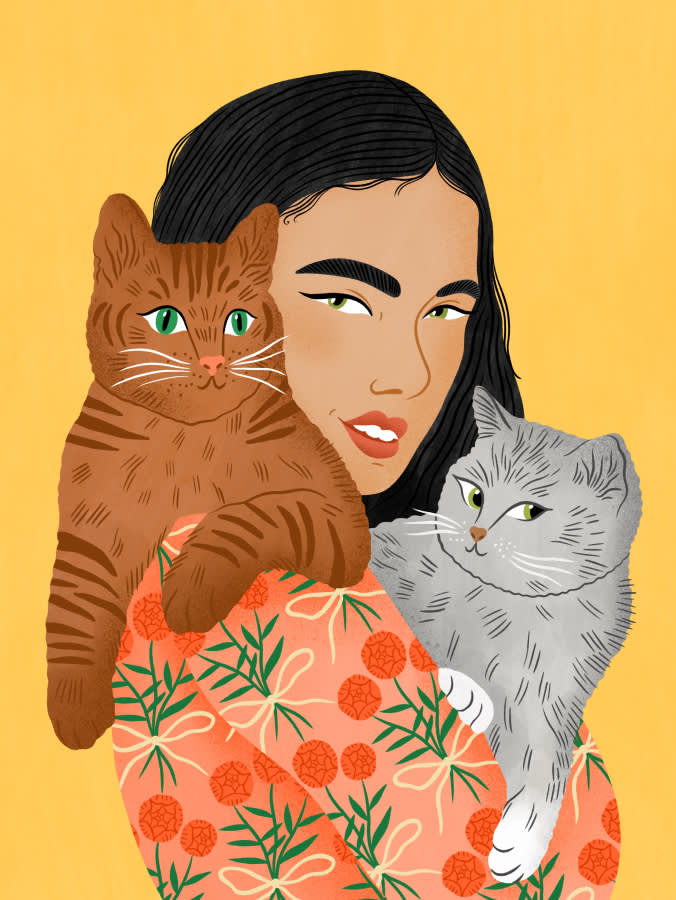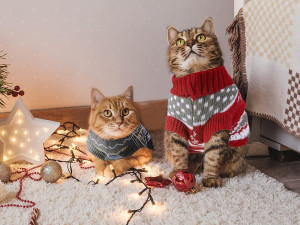The Story Behind the Iconic Cat Eye
This feline-inspired makeup trend continues to reign supreme.
Elizabeth Taylor was one of a kind, but one of her signature looks was influenced by an animal just as iconic as her legacy: the cat.
Here’s the story behind the makeup trend with as much staying power as a classic Hollywood star...and those who followed in her footsteps.
Save on the litter with color-changing tech that helps you better care for your cat.
There’s a lesser-known Taylor movie from 1974 called The Driver’s Seat. Based on a metaphysical novella opens in new tab by the great Muriel Spark, it features a cameo by Andy Warhol as a British nobleman and stars Taylor as a woman teetering dangerously on the edge. This all sounds like a recipe for cinematic greatness. Despite all that, the film was reportedly met by silence during its premiere at Cannes and was mostly ignored by critics.
Since then, thankfully, like so much else, it has since been embraced by a certain subset opens in new tab of film and fashion fans who appreciate its deranged glamour and absurd dialogue. Beauty hobbyists and professionals have happened upon the movie for another reason: a minute-long scene of Taylor in a bathroom mirror carefully applying her eye makeup, layering shadow and rimming kohl around those famous violet eyes.
Taylor was actually known for being quite adept at doing her own makeupopens in new tab. In fact, she painted her own faceopens in new tab for what is widely considered her most famous makeup role: as the titular Cleopatra in the epic 1963 filmopens in new tab. The makeup artist for the film, Alberto De Rossi, had a serious injury, so Taylor was left to take inspiration from his sketches and DIY. Her makeup handiwork would produce one of the most archetypal and most referenced cat eyes of all time.
The extended feline-like makeup flick, which has come to be known as the cat eye, is many centuries old, believed to have originated in ancient Egypt where it was favored by men and women alike, including famous ones like Cleopatra and Nefertiti. The cat eye, thought to also be a sartorial form of protection against the “evil eye,” was back then achieved with minerals like malachite and copper ore, per Vogueopens in new tab.
When the look experienced a resurgence in the 1920s, it was stoked perhaps in part by the 1917 big screen version of Cleopatra starring silent film actress Theda Bara, and also by the incandescent Josephine Baker who often sported a feline flick on stage. Women then often relied on a blend of Vaseline and soot to create their cat eyes, Richard Corson details in Fashions in Makeup: From Ancient to Modern Times opens in new tab(2010).
When the look was picked up again in the 1960s by titans of glamour such as Taylor, Sophia Loren, Maria Callas, Barbra Streisand, and Brigitte Bardot (a trademark of her sultry look opens in new tab that she was rarely spotted without), application of it had become somewhat easier thanks to the 1950s invention of liquid lineropens in new tab.
From then on, the cat eye would never lose its style favor, though it would go through many incarnations and find some unlikely fans. Icons of the 1970s punk movement like Soo Catwoman and Siouxsie Sioux pushed the boundaries of the look, literally, extending their (fe)-line to cover the entire eye socket, and sometimes, as Soo did, filling it in with acid-green eyeshadow. Diane Lane’s turn as Corinne Burns in 1982’s cult favorite punk rock film Ladies and Gentlemen, the Fabulous Stainsopens in new tab, included an exaggerated interpretation of the cat eye, complete with red flames extending above her brows.
Edie Sedgwick and Twiggy cat-eyed, pairing the look with major lashes, same goes for Diana Ross. It was part of how Elvira Mistress of the Dark got into characteropens in new tab; a densely underlined version is a longtime signature of visual artist Shirin Neshat; and singers from Ariana Grande to Beyoncéopens in new tab and Adele to — most infamously — Amy Winehouse, have made it a significant part of their look.
But as ubiquitous a look as it has become (the search term “cateye” on TikTok has over 800 million views), the task of creating it is one that feels daunting to many. A slender, brush-tipped pen is what New York-based makeup artist Suzy Gerstein recommends (this is her favoriteopens in new tab) for the most ease of application and precision. “Lean the brush as close into the base of your lashes as you can get it,” says Gerstein. “If you have shaky hands, keep your arms in close to your body and try steadying your elbow on a counter or table.”
If even that seems daunting, says Gerstein, a tool like this oneopens in new tab by Guide Beauty, a line of ability-inclusive beauty accessories with Selma Blair as its chief creative officer, can help. “I was skeptical at first but now I gift it to friends, family and clients who don’t have steady hands but love the look of a cat eye.”
For those who feel more confident with a powder eyeshadow, Gerstein likes the ones from Neenopens in new tab (especially the peacock color) for their smooth application and dense pigment. “Just dip an angled brush into some water or a waterproofing product like Inglot Duraline and you have yourself a custom liquid liner,” says Gerstein, adding that cotton buds and micellar water like Bioderma should be kept handy for perfecting your line.
As for twists on the classic, nowadays there are countless. Gerstein loves a bright colored cat eye, a dual-colored neon, and a cat eye with negative space. “A reverse cat eye works with many eye and face shapes too and is nice when you have hooded or deep-set eyes with less real estate on top,” she explains.
Why the cat eye’s appeal has endured for centuries now is in part because of its infinite adaptability, says Gerstein, and that it’s incredibly flattering. “It’s a powerful means of play, even self-expression,” she adds. It also, in these pandemic times when our faces have been so often masked, never fails in its ability to draw attention to one feature that hasn’t been under wraps.






